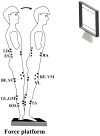Early postural adjustments in preparation to whole-body voluntary sway
- PMID: 22142740
- PMCID: PMC3246119
- DOI: 10.1016/j.jelekin.2011.11.005
Early postural adjustments in preparation to whole-body voluntary sway
Abstract
We studied postural adjustments associated with a quick voluntary postural sway under two conditions, self-paced and simple reaction-time. Standing subjects were required to produce quick discrete shifts of the center of pressure (COP) forward. About 400-500ms prior to the instructed COP shift, there were deviations of the COP in the opposite direction (backwards) accompanied by changes in the activation levels of several postural muscles. Under the reaction-time conditions, the timing of those early postural adjustments did not change (repeated measures MANOVA: p>0.05) while its magnitude increased significantly (confirmed by repeated measures MANOVA: p<0.05). These observations are opposite to those reported for anticipatory postural adjustments under simple reaction time conditions (a significant change in the timing without major changes in the magnitude). We conclude that there are two types of feed-forward postural adjustments. Early postural adjustments prepare the body for the planned action and/or expected perturbation. Some of these preparatory actions may be mechanically necessary. Later, anticipatory postural adjustments generate net forces and moments of force acting against those associated with the expected perturbation. Both types of adjustments fit well the referent configuration hypothesis, which offers a unified view on movement-posture control.
Published by Elsevier Ltd.
Figures





Similar articles
-
Anticipatory postural adjustments and anticipatory synergy adjustments: preparing to a postural perturbation with predictable and unpredictable direction.Exp Brain Res. 2017 Mar;235(3):713-730. doi: 10.1007/s00221-016-4835-x. Epub 2016 Nov 19. Exp Brain Res. 2017. PMID: 27866261 Free PMC article.
-
Flexibility of anticipatory postural adjustments revealed by self-paced and reaction-time arm movements.Brain Res. 1997 Jun 27;761(1):59-70. doi: 10.1016/s0006-8993(97)00260-6. Brain Res. 1997. PMID: 9247066
-
Postural adjustments associated with voluntary contraction of leg muscles in standing man.Exp Brain Res. 1988;69(3):469-80. doi: 10.1007/BF00247301. Exp Brain Res. 1988. PMID: 3371431
-
Two aspects of feedforward postural control: anticipatory postural adjustments and anticipatory synergy adjustments.J Neurophysiol. 2011 May;105(5):2275-88. doi: 10.1152/jn.00665.2010. Epub 2011 Mar 9. J Neurophysiol. 2011. PMID: 21389305 Free PMC article.
-
Physiological and circuit mechanisms of postural control.Curr Opin Neurobiol. 2012 Aug;22(4):646-52. doi: 10.1016/j.conb.2012.03.002. Epub 2012 Mar 23. Curr Opin Neurobiol. 2012. PMID: 22446009 Free PMC article. Review.
Cited by
-
A Novel Viewpoint on the Anticipatory Postural Adjustments During Gait Initiation.Front Hum Neurosci. 2021 Oct 11;15:709780. doi: 10.3389/fnhum.2021.709780. eCollection 2021. Front Hum Neurosci. 2021. PMID: 34707487 Free PMC article.
-
Muscle synergies in preparation to a step made with obstacle in elderly individuals.J Neuroeng Rehabil. 2015 Feb 4;12(1):10. doi: 10.1186/s12984-015-0005-9. J Neuroeng Rehabil. 2015. PMID: 25656738 Free PMC article.
-
Control of vertical posture while elevating one foot to avoid a real or virtual obstacle.Exp Brain Res. 2017 Jun;235(6):1677-1687. doi: 10.1007/s00221-017-4929-0. Epub 2017 Mar 7. Exp Brain Res. 2017. PMID: 28271221
-
Time scale dependence of the center of pressure entropy: What characteristics of the neuromuscular postural control system influence stabilographic entropic half-life?Exp Brain Res. 2015 Dec;233(12):3507-15. doi: 10.1007/s00221-015-4420-8. Epub 2015 Aug 25. Exp Brain Res. 2015. PMID: 26303025
-
Two Aspects of Feedforward Control During a Fencing Lunge: Early and Anticipatory Postural Adjustments.Front Hum Neurosci. 2021 Jun 14;15:638675. doi: 10.3389/fnhum.2021.638675. eCollection 2021. Front Hum Neurosci. 2021. PMID: 34194305 Free PMC article.
References
-
- Aruin AS, Forrest WR, Latash ML. Anticipatory postural adjustments in conditions of postural instability. Electroencephalogr Clin Neurophysiol. 1998;109(4):350–9. - PubMed
-
- Aruin AS, Latash ML. Directional specificity of postural muscles in feed-forward postural reactions during fast voluntary arm movements. Exp Brain Res. 1995;103(2):323–32. - PubMed
-
- Belen'kii VE, Gurfinkel VS, Pal'tsev EI. Control elements of voluntary movements. Biofizika. 1967;12(1):135–41. - PubMed
-
- Benvenuti F, Stanhope SJ, Thomas SL, Panzer VP, Hallett M. Flexibility of anticipatory postural adjustments revealed by self-paced and reaction-time arm movements. Brain Res. 1997;761(1):59–70. - PubMed
-
- Bouisset S, Zattara M. Biomechanical study of the programming of anticipatory postural adjustments associated with voluntary movement. J Biomech. 1987;20(8):735–42. - PubMed
Publication types
MeSH terms
Grants and funding
LinkOut - more resources
Full Text Sources
Medical

